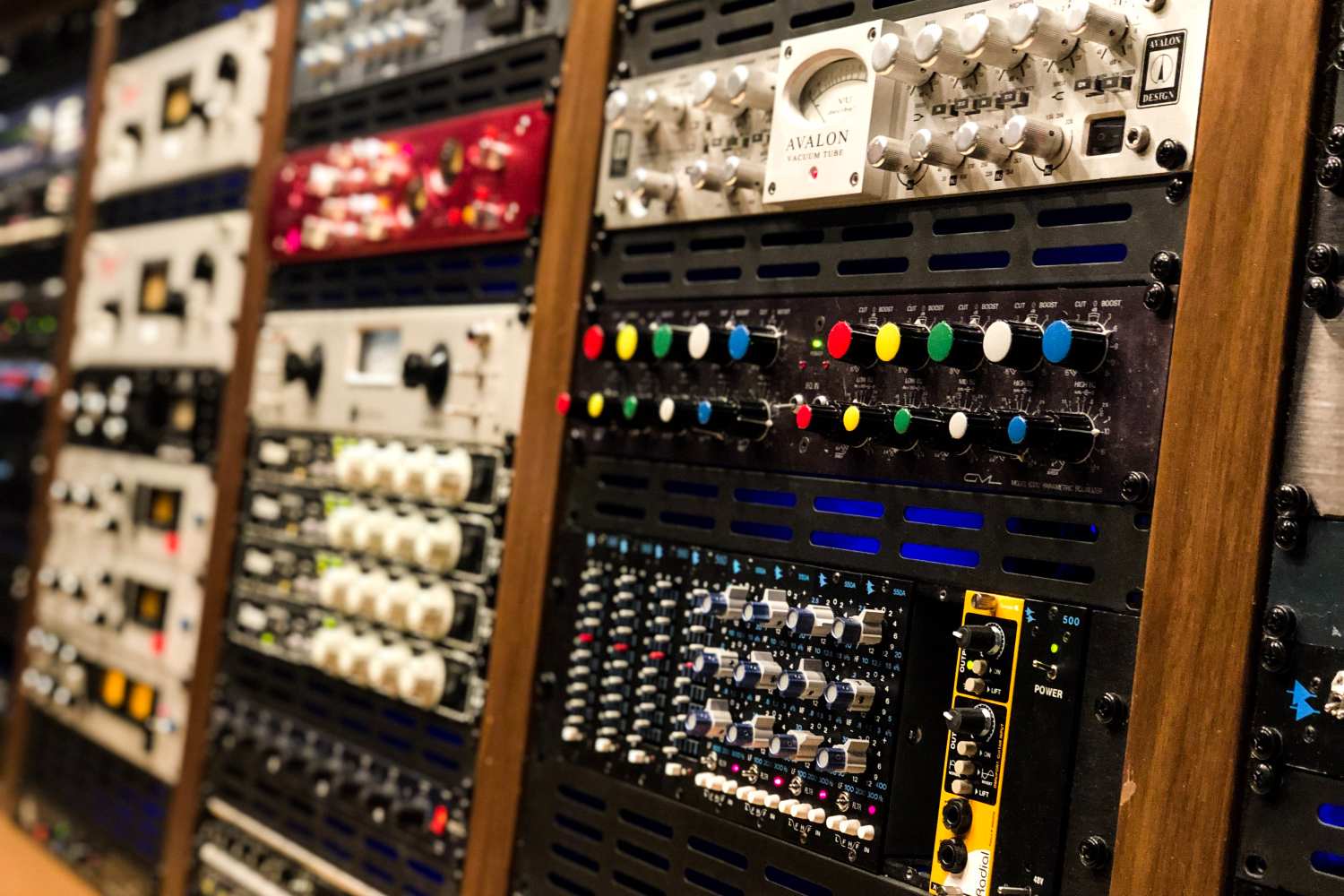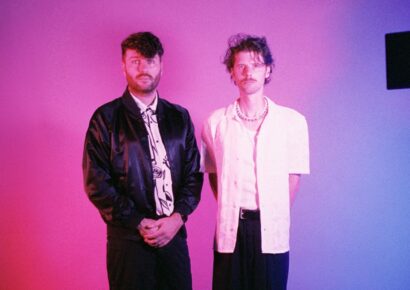A race for the tone shaped top.
For those of you paying attention, we recently dropped Part One of our take on the 10 greatest hardware equalisers of all time, with five distinctly different equalisers, each sporting wildly different designs and characters of their own.
If there is anything to be learnt from the list so far, it’s that like classic hardware compressors, the EQ landscape is an incredibly diverse one, full of unique topographies and distinct sonic fingerprints. Whether taken from consoles of old or neatly housed in their own 500 series racks, whether boasting mind-bending flexibility or lightly brushing up against our source material, each of these equalisers serves a purpose, but what about the final five?
Read all the latest features, columns and more here.
None of these magnificent beasts are here by coincidence, favouritism or merely to fill the void-but rather for the immeasurable imprint they have left on recorded music history.
Part Two, the race to the top spot, we unveil our pick of the very best hardware equalisers.
5. Chandler Limited Curve Bender
We start off Part Two with a modern take on a serious bit of console history. Based on the EQ section from the coveted Abbey Road Studios EMI TG 12345 console from the late 1960s. This transistor-based console was a departure from the previous REDD valve based consoles at Abbey Road, and the TG 12345 would play home to the recordings and mixes of such artists as The Beatles (Abbey Road), The Shadows, and Pink Floyd (most notably on the latter’s Dark Side of the Moon) among a murderers row of other classic albums in rock and pop history.
Decades on from the inauguration of this console, Chandler Limited teamed up with Abbey Road Studios gaining the exclusive rights to recreate some of the most famous recording equipment the world has ever known. Wade Geoke, the genius mind and founder of Chandler Limited wanted to take the far more stripped down EQ section of the original TG 12345 console, bringing it into the now and fleshing it out with additional EQ bands, shapes, filters and so on. The final result, the Curve Bender Mastering EQ.
Certainly not exclusively used for mastering, this absolute leviathan of an EQ justifies its appropriateness on so many instruments and sources within a mix, it’s borderline unfair, the kind of magic this beast can impart sonically, without ever becoming overzealous.
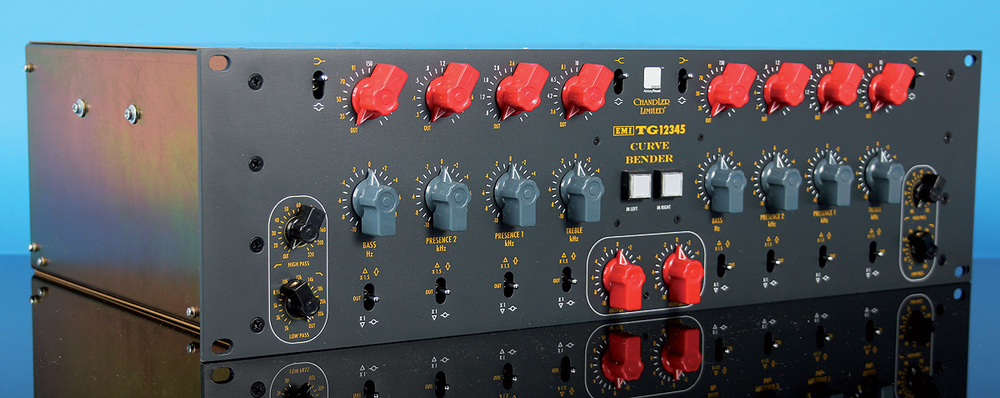
Compared to many of the others on the list so far (with the GML 8200 being an exception), the Curve Bender isn’t an EQ designed to be absolutely pinned with 15dB worth of gain, nor punctiliously corrective. Rather its natural inclination is as a gentle tone shaper, with small movements and broad brushstrokes across the frequency spectrum, quantifying to something beautifully organic, lush and musical. For the Curve Bender, the magic lies in its subtlety. It’s not a hatchet job after all.
Four bands, a myriad of EQ points (51 in total), multiple switches for Q adjustment and the amount of boost/cut made available (ranging from either +/-5dB or +/- 13.5dB), shelf or bell switches for the low and high bands as well as high and low pass filters. Yep, that’s all you get. It’s pretty near impossible to make things sound bad with this thing. As mentioned earlier, its magic is in its subtlety, but if pushed will just grace you with more depth and power. The circuit topology and dumbfounding attention to detail under the hood is truly a work of art and gives a glimmer of insight as to why this EQ sounds the way it does – smooth, soft, rich, glowing.
Notable artists and tracks with a sprinkling of Curve Bender magic include Adele (Rolling in the Deep), White Stripes (Icky Thump), The Strokes (Pink Martini), The Lumineers (Cleopatra), the list goes on and on.
4. Neve 1073
The EQ that has saved thousands of assistant engineers and the ultimate concealer of questionable mic technique, of course the 1073 was going to make an appearance on this list.
One of the founding fathers of modern recording, Mr Rupert Neve infamously pioneered some of the most revered electrical audio circuits the world has ever known. His transistor based designs of the late ’60s and through the ’70s entirely revolutionised the sound of recorded music of the time and still influences the sounds and approaches to modern recording to this day.
While his Class A transformer-based preamps are monolithic in their sonic signature, their accompanying equalisation sections were, and still are, equally as bold and beautiful.
While there are numerous Neve EQ circuits to choose from, and a quick search of the countless audio forums will no doubt argue that there’s “better” more “versatile” Neve EQs out there, the 1073 module is without doubt the most identifiable, widely used, and talked about.
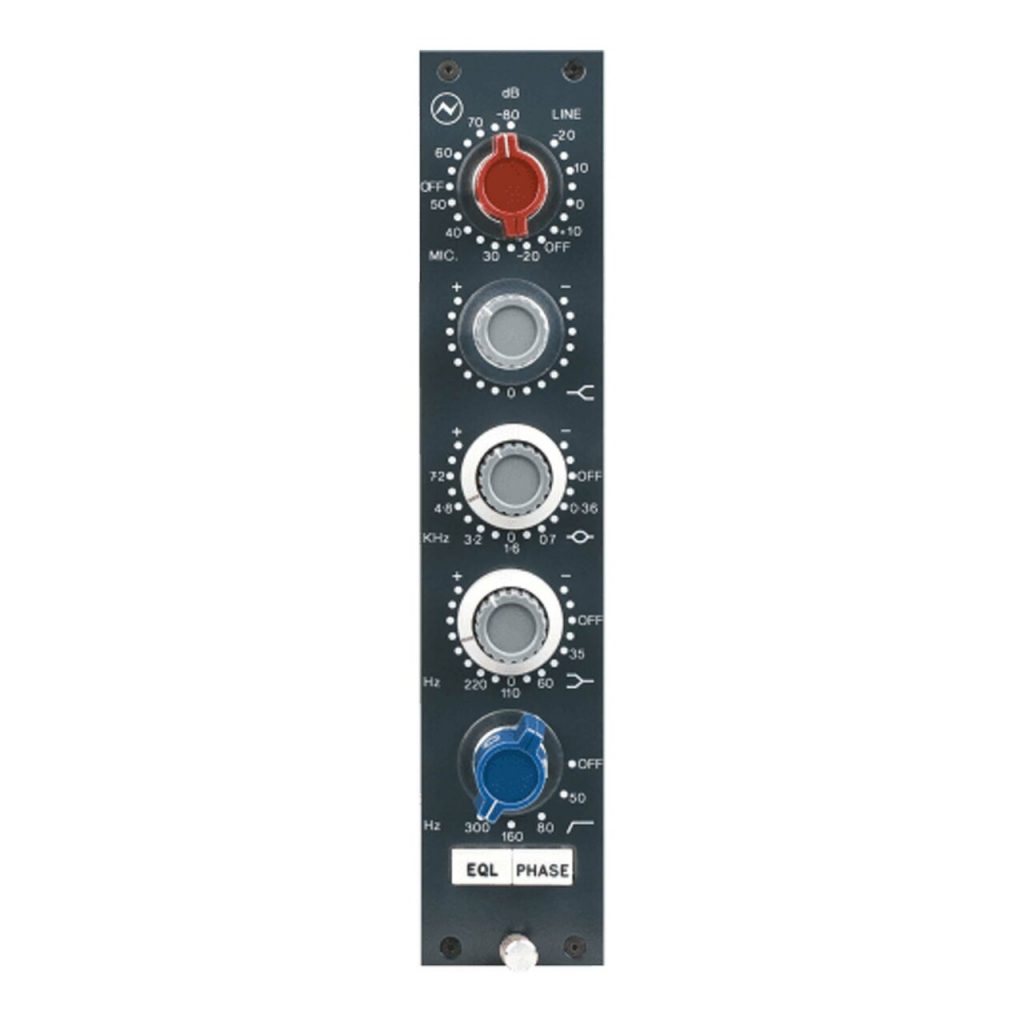
Aside from the lauded Class A preamp section, the relatively simple but incredibly powerful three band EQ section has shaped the tones of literally thousands of records. The low band shelf offers four selectable frequencies, each providing a sweet spot to add punch, weight and thickness to a sound source, from kick drums, through to snares, basses, guitars, vocals and so on. The six position mid-band is a bell curve and provides wonderful control and shaping of the midrange with a wide range of frequencies available, while the high frequency shelf is fixed at 12kHz, with a healthy amount boost or cut available for sweeping the top end, without leaving brittle artefacts. The high pass filter offers four frequencies and works oh so musically, particularly when used in conjunction with the low frequency band.
The simplicity of the 1073 EQ is absolutely part of its charm, with its broad, musical bandwidth making it one of the most musical sounding EQ’s ever created. It’s thick, deep and never harsh. An absolute dream to record through or for using later in post, the 1073 is a true workhorse and staple of the modern recording studio. Notable users include Joe Chiccarelli, Ed Cherney, Jacquire King, Ryan Hewitt, Andrew Scheps, and so on goes the list.
3. API 550A/560
Ok, ok, while we technically have two EQ’s coming in at number three, the API 550A and 560 were essentially released as a pair, two peas in a pod, forever interlinked. Not to mention these EQ’s (along with the consoles they were installed in) essentially shaped the ‘larger than life’ sound of American rock in the 1970’s. No biggy. Cool, now that that’s out of the way, let’s talk API.
Audio pioneer Saul Walker designed these coveted EQ circuits in the late 1960s, bringing the world his custom 2520 discrete Class A/B operational amplifier combined with his Proportional Q circuit. Proportional Q, eh? Something that makes these EQ’s rather special and intimately identifiable in terms of sonic character. In a nutshell, as you boost or cut more in each band, the Q becomes proportionally sharper. And in gentler settings, the Q is more broad.
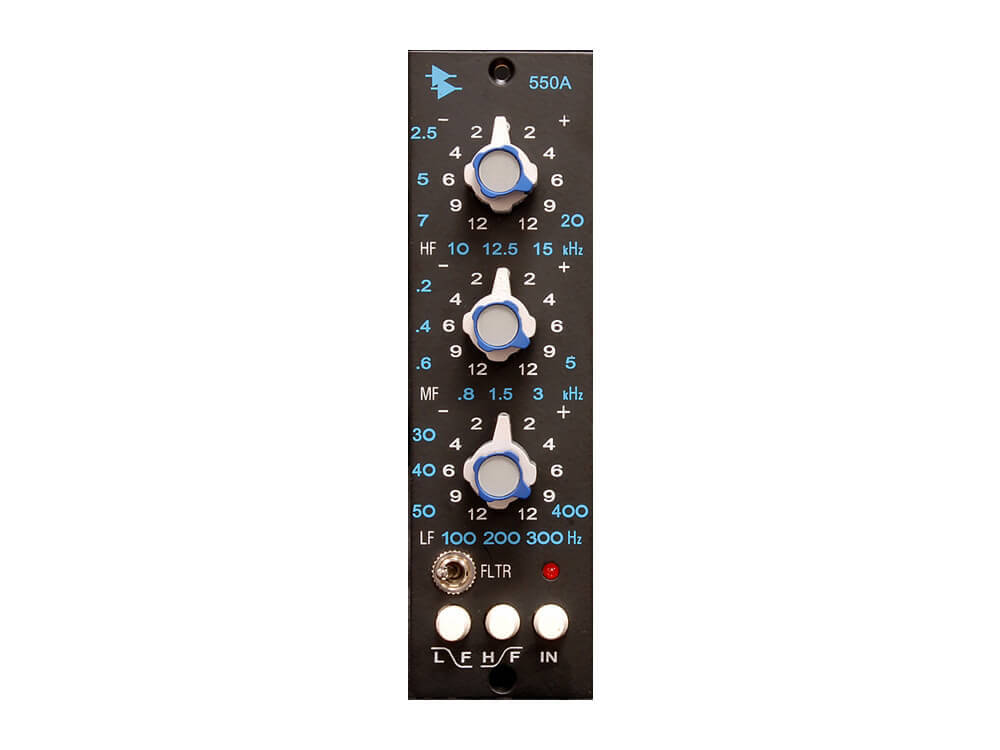
While they may share a release date and console, the 550A and 560 are very much fraternal twins and can be identified as below:
550A – A three-band parametric EQ, with crossover frequencies per band and seven fixed frequencies per band. 12dB boost or cut. High and low bands can be switched between shelf and peak shapes and a band-pass filter switch (50Hz and 15kHz) can be engaged for rolling off lows and highs simultaneously.
560 – A 10-band graphic EQ providing +/-12dB of gain per band. Like the 550A, the 560 enjoys the benefits of the unique proportional Q design, and being a 10-band graphic, can create some wonderfully broadband boosts or cuts with a sharp, focused frequency centre which softly (or sharply) slopes away, depending how many bands of the EQ are engaged and to what degree of boost or cut. I couldn’t recommend digging into experimenting with this more!
While separate units, both the 550A and 560 EQ’s were installed together or interchangeably into vintage API consoles of the 1970s, before becoming a favoured EQ of studios across the globe. Their distinct punch, upfront character and ability to quickly and easily shape sounds has made them a mainstay in the world of hardware EQ, whether installed in a console old or new or found in a 500 series rack (or in the case of the 550, a dual/stereo 1RU rack version). Notable users include Joe Chiccarelli, Vance Powell, Peter Katis, Darrel Thorp amongst many more.
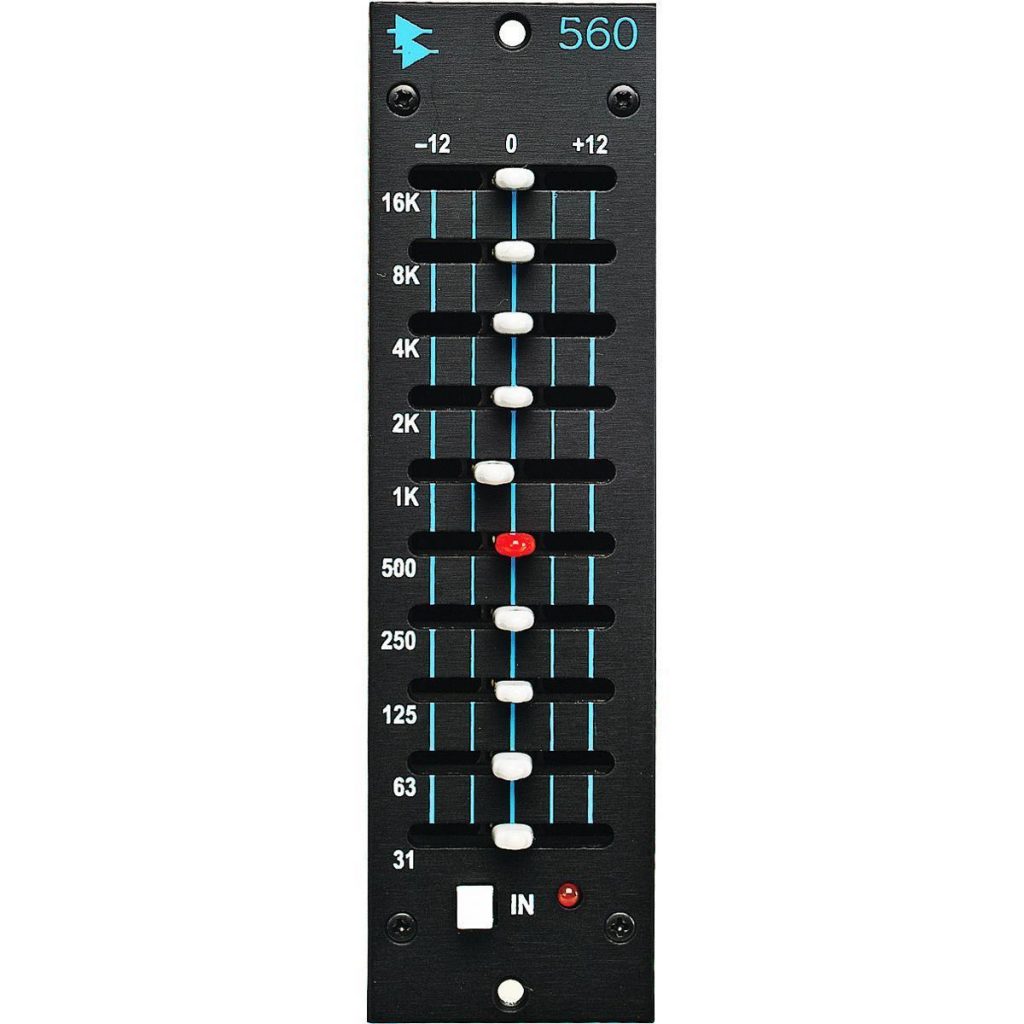
2. Pultec EQP-1
Sometimes you just can’t beat an absolute classic and the Pultec EQP-1 is everything that encompasses classic, vintage charm. If the LA-2A is the quintessential ‘Classic’ studio compressor, than the Pultec EQP-1 is undoubtedly its EQ equivalent, casting one of the most identifiable veneers in the studio landscape. It’s also one of the most mysterious pieces of equipment out there, its head scratching design resulting in all kinds of beautiful accidents on the quest for sonic nirvana.
For starters, there really is something in vacuum tubes that gets even the most “modern” producer excited. Whether it’s additional harmonics, saturation or helping colour, something happens to signals when they pass through the EQP-1 that seems to just work. Something beyond just mere cutting and boosting.
Introduced in 1951 by company owners and founders Ollie Summerland and Gene Shark, the Pultec EQP-1 was the world’s first passive program equaliser and to this day its influence is still being felt in any number of modern passive EQ designs and plugin emulations.
There really is something truly magical about this EQ, even when the EQ section isn’t engaged, the tube topology adds character and charm to sound sources like no other piece of hardware. And who would think such a simple set of controls would still be so widely used seventy plus years on.
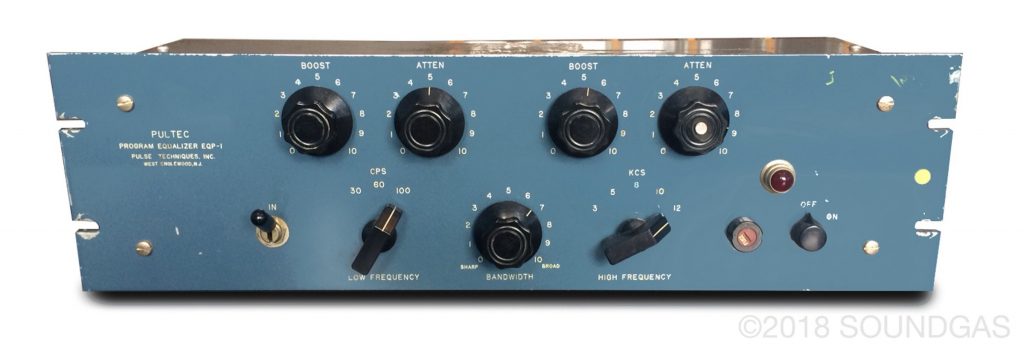
The basic layout of the EQP-1 looks simple enough at first glance, with low band and high frequency bands, with the most rudimentary set of controls, by today’s standards at least, remember, this is the 1950’s.
Boost and attenuation controls are available for the low frequency band, with the high band only being able to boost, but also provides an additional bandwidth control. The low band has four frequencies to choose from, 20Hz -100Hz, whilst the high band has seven, being 3kHz, -16kHz. The attenuation section for high frequencies can be selected at either 5kHz, 10kHz or 20kHz.
Bringing a smoothness and incredibly musical tonality to any sound source directly or when put on the master buss, the EQP-1’s distinctly tube harmonic character is unrivalled. The broad range of the low band adds roundness and heft to low frequency sources, whilst the high frequency band, depending on where you set it, can add engaging presence in the upper-mid range or sparkly, silky smooth air to the tops.
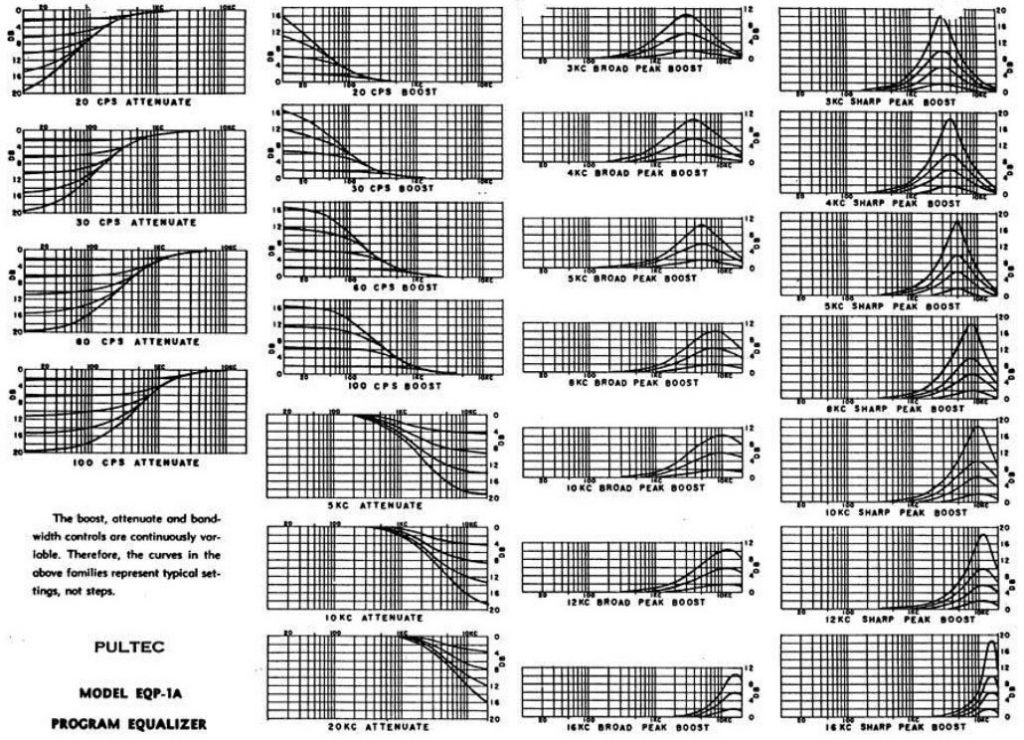
The final and perhaps most mysterious element of all lies in its ability to both boost and attenuate simultaneously, producing a whole manner of interesting and useful results.
Although not recommended in the manual, due to the boost gain being slightly higher than that of the attenuation, serves as a perfect storm for unique undulating, EQ curves.
When dialled in correctly, the subsequent tone shaping this allows for is truly something to behold, with engineers passing on different Pultec ‘tricks’ from one generation to the next. This ability to create these shapes by deliberately misusing has very much become part of the charm and folklore surrounding this EQ. Notable users of the EQP-1 include Bob Clearmountain, Jimmy Douglas, Andrew Scheps and countless others.
1. SSL 4000 E/G
It’s been a journey through old and new, from tone shaping behemoths to surgically precise sculptors, we’ve counted down through the best of the best in the world of equalisers. But, as all Greatest of All Time lists do, there can only be one. One EQ to rule them all, one EQ to bind them.
Even if you didn’t know it, I can almost guarantee you’ve heard the sound of an SSL 4000 E/G console, and quite frankly you’d have to have been living off the grid to have not heard a song or record that hasn’t had this console’s distinct sonic character imprinted upon it.
The Solid State Logic (SSL) 4000 series consoles held the lion’s share of hit records throughout the 1980s and into the 90s, and without doubt completely changed the world of recorded music.
Aside from being one of the most feature-packed channel strips of its time (and still to this day I might add), it’s the SSL 4000’s EQ that really shines through as something exceptionally special. It was the introduction of the 4000 E in 1983 that the famed “Black Knob” EQ made it stamp. To start, the EQ section was created in collaboration with none other that Sir George Martin (producer of The Beatles), so already this EQ had some golden ears attached to it. The four band EQ section is feature packed, including sweep-able low and high bands, switchable between either shelf or bell shapes, two sweeping mid-bands with a wide Q range for ultra precise cuts or broad musical boosts, plus, high and low pass filters.
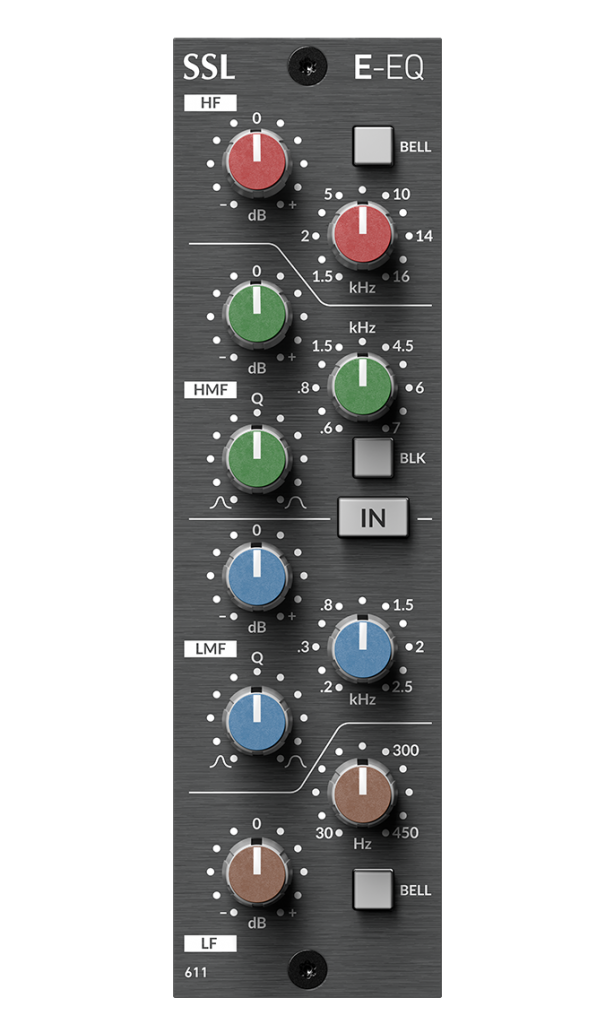
The incomparable spank and excitement the EQ brings to a multitude of sound sources is really what gets people excited, when it comes to SSL EQ’s like the G and E series. One doesn’t have to do much for the EQ to really start singing and its ability to be pushed hard allows engineers, producers and mixers to really dig in and get aggressive when need be, allowing sounds to be pushed upfront without ever getting too unruly. This kind of front and centre clarity is the 4000’s calling card.
The EQ’s midrange section is quite famous for its musicality and one of the go-to mix recipes in modern mixing practice, particularly for getting guitars to glue and stick in the mix. Also of note is the EQ’s bottom end and its ability to add a distinct heft, weight and aggression to low end instruments, combined with nifty shaping ability and the presence of both shelf or bell options to get the desired effect.
Notable users of the SSL 4000 series consoles include none other than Bob Clearmountain, Trevor Horn, Young Guru, Michael Brauer and famously, brothers Chris and Tom Lord-Alge (aka CLA and TLA), not to mention the legions of other top engineers, mixers and producers.
While the big console era of recording might be behind us, it is SSL EQs that have also made the smoothest transition into the plugin market, with the various G and E series emulations becoming a mainstay in in the box workflow, with abridged, parred backed versions of their iconic layout also finding a home on modern SSL creations like the SSL SiX and UC1 plugin controller-a testament to their position as a mainstay of the professional production workflow.
It’s for these reason and many more, that the mighty SSL 4000 EQ is our pick as the greatest hardware EQ.
Check out Part One here!
